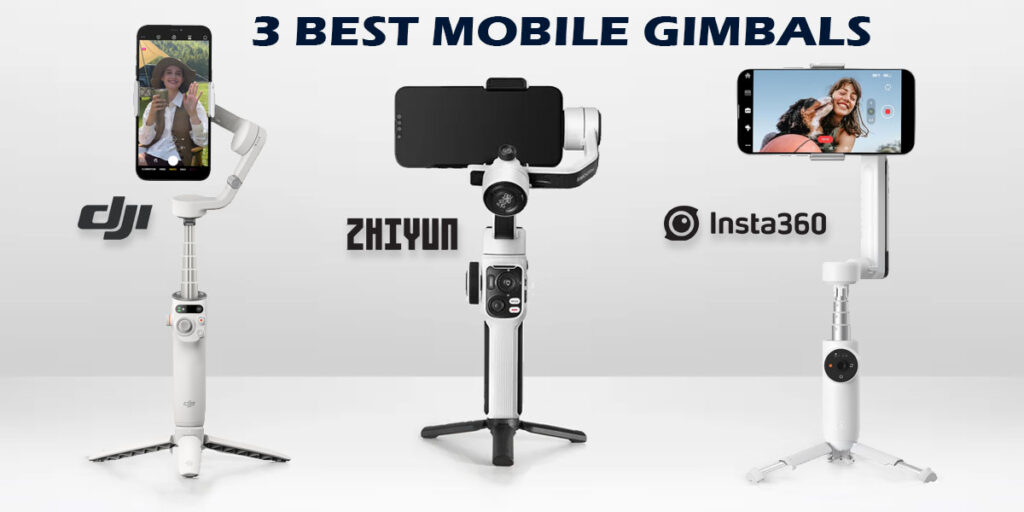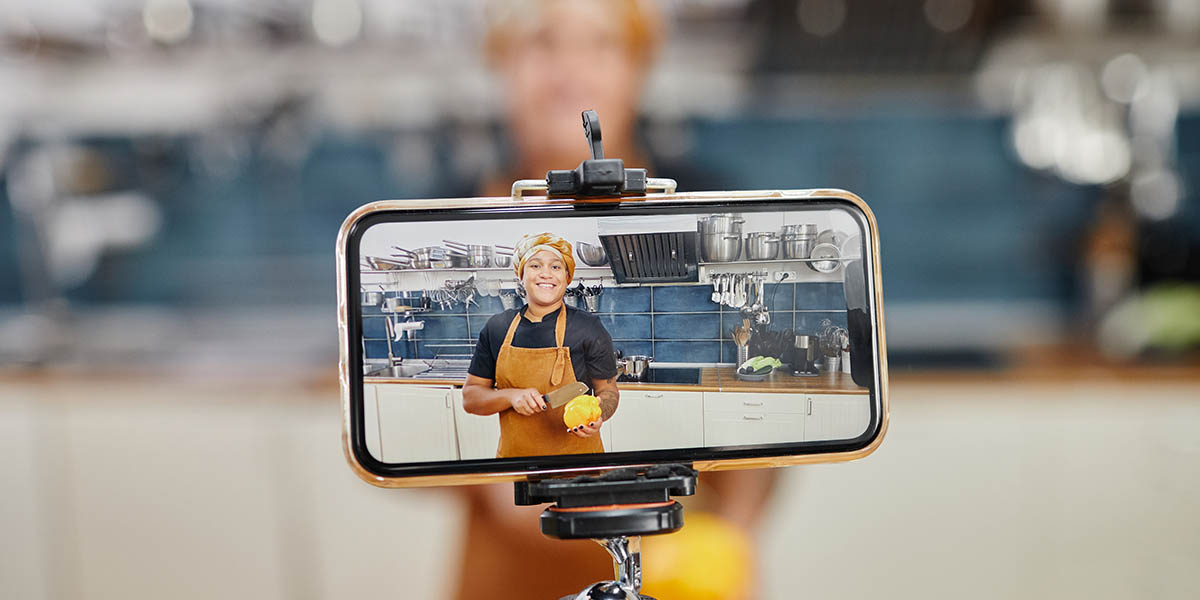So you want to become a content creator and are unable to afford professional equipment. Don’t sweat it, there are many options to getting started and that can easily be accomplished with you’re mobile phone.
I have been creating content professionally for over 30 years and one of my best tools is a mobile phone. Let me tell you one story in particular where if it wasn’t for mobile phones we would not have captured any footage.
I’m in Dubai and we prepared for a shoot with camels and humans. We had 2 professional cameras and a drone to capture everything. Once arriving in the desert, we set up and started filming… Well that didn’t last very long, it was over 50° Celsius, that’s over 122° Fahrenheit. The drone and cameras simply couldn’t handle the heat and stopped working. All I can say is thank you for mobiles and the quality of video they can produce.
Okay enough, lets get started.
3 Best Mobile Gimbals 2025
Whether you’re a vlogger, filmmaker, or just love creating stunning videos for social media, a mobile gimble can elevate your content to professional levels. But with so many options on the market,

Article Outline:
Introduction to Mobile Videography
Imagine capturing life’s fleeting moments with cinematic flair, right from your pocket. That’s the power of mobile videography. It’s an art form that has democratized filmmaking, turning smartphone owners into potential cinematographers. But what exactly is mobile videography, and why has it become such a phenomenon?
Mobile videography is the craft of creating video content using mobile phones. This form of content creation has surged in popularity due to the ubiquity of smartphones equipped with high-quality cameras capable of recording in HD or even 4K. The convenience of having a camera always at hand has enabled creators to document their lives, tell stories, and express their creativity spontaneously.
The rise of mobile videography can be attributed to several factors:
- Quality: Modern smartphones boast advanced camera systems that rival traditional video cameras, offering features like optical image stabilization, slow motion, and time-lapse.
- Convenience: The compact size of smartphones allows videographers to shoot in a variety of environments without the need for bulky equipment.
- Creativity: With an array of apps for editing and effects, creators can experiment with their footage directly on their device, pushing the boundaries of their creative vision.
- Connectivity: Instant access to the internet means that videos can be shared with a global audience at the tap of a screen, fostering a culture of immediate content consumption and feedback.
As mobile videography continues to evolve, it’s not just about the technology; it’s about the stories being told. It’s a medium that empowers creators to share their perspectives with the world, whether it’s through a vlog, a travelogue, a documentary, or even a short film. The narrative is no longer confined to the written word or static images; it’s dynamic, it’s visual, and it’s immediate. With mobile videography, storytellers have the freedom to weave their tales in real-time, capturing the essence of their message through the lens of their phone.
The Impact of Mobile Videography
The impact of mobile videography extends beyond personal storytelling. It has become a powerful tool for journalism, activism, and education. Citizen journalists can report from the ground, activists can document events as they unfold, and educators can create immersive learning experiences. The immediacy of mobile videography allows for a genuine, unfiltered view of the world, making it a potent medium for raising awareness and driving change.
The Community of Mobile Videographers
A vibrant community of mobile videographers has emerged, connected by social media and online platforms where they share their work, exchange tips, and inspire each other. This community is not just about sharing content; it’s about sharing knowledge, experiences, and a passion for visual storytelling.
The Future of Mobile Videography
As we look to the future, the possibilities for mobile videography are as limitless as the creativity of those who wield the camera. Advancements in technology will continue to enhance the capabilities of mobile devices, making them even more powerful tools for videography. We can expect to see more sophisticated editing apps, improved camera features, and perhaps even new forms of content that we haven’t yet imagined.
Mobile videography is not just a trend; it’s a cultural shift in how we capture and share our experiences. It’s a testament to the power of technology to empower individuals and democratize the art of filmmaking. So, whether you’re a professional videographer or someone who loves to capture the beauty of everyday life, mobile videography is a medium that offers endless opportunities to tell your story, your way.
Why Mobile Content Creation is Thriving

In an era where everyone has a story to tell, mobile content creation is not just thriving; it’s revolutionizing the way we communicate, share, and connect.
Here are some reasons why this medium has become so popular:
- Accessibility: Almost everyone has a smartphone, making it incredibly easy to start creating content without the need for expensive equipment.
- Social Media Influence: Platforms like Instagram, TikTok, and YouTube have created vast audiences eager for fresh, authentic content that only mobiles can deliver with their immediacy.
- Technological Advancements: The quality of mobile cameras has skyrocketed, often rivaling traditional cameras, enabling creators to produce high-quality content on the go.
- Creative Freedom: Mobile content creation empowers individuals to express themselves freely, without the constraints of traditional media production.
- Community and Collaboration: Social media and content platforms have fostered communities where creators can collaborate, share tips, and support each other.
- Monetization Opportunities: Many platforms offer ways to monetize content, providing a financial incentive for creators to produce mobile content.
- Real-Time Engagement: Live streaming and instant updates allow for real-time interaction with audiences, creating a more engaging experience.
- Portability: The compact nature of smartphones means you can capture moments as they happen, no matter where you are.
- User-Friendly Editing Apps: A plethora of editing apps make it simple to edit and enhance videos directly on the phone, streamlining the content creation process.
- Personalization: Mobile content often feels more personal and relatable, resonating with viewers who seek genuine connections.
The combination of these factors has created an environment where mobile content creation isn’t just a trend; it’s a mainstay of modern communication. As technology continues to evolve, we can only expect this movement to grow stronger, offering endless possibilities for creators worldwide.
How to Get the Most Out of Mobile Videography
Mobile videography is not just about hitting the record button on your smartphone; it’s an art that requires a blend of creativity, technique, and the right tools. Here are some tips to help you maximize the potential of mobile videography and create content that stands out.
Understand Your Equipment
Before you start filming, take the time to understand the capabilities and limitations of your smartphone camera. Familiarize yourself with its settings, such as resolution, frame rate, and focus options. Knowing your equipment inside out will allow you to make quick adjustments and capture the best footage possible.
Invest in Accessories
While your smartphone is a powerful device on its own, accessories can elevate your videography game. Consider investing in a few pieces of equipment listed below:
- Gimbals: For stable and smooth footage. Read my article on Gimbals.
- External Microphones: To improve audio quality.
- Lighting: Good lighting is crucial for high-quality video.
Composition and Framing
Good composition is key to engaging videos. Use the rule of thirds to frame your shots, and don’t be afraid to experiment with different angles and perspectives. Remember, the way you frame your subject can tell a story on its own.
Lighting Matters
Lighting can make or break your video. Whenever possible, use natural light to your advantage, the beauty of mobile phones is they typically adjust automatically, unless you are using the “pro mode”. If you’re shooting indoors, additional lighting equipment can help avoid grainy and underexposed footage.
Steady Shots
Shaky footage can be distracting. Use a gimbal or tripod to keep your shots steady. If you don’t have one, stabilize your elbows against your body or use a wall for support. A gimbal is the simplest and will give you the least amount of trouble.
Focus on Audio
Clear audio is just as important as clear video. Use an external microphone if possible, and try to minimize background noise. Sometimes, the audio tells more of the story than the visuals.
Edit Like a Pro
Editing is where the magic happens. Use mobile editing apps to cut, splice, and polish your footage. Add music, transitions, and effects to enhance the storytelling.
Tell a Story
Every video should tell a story. Plan your shots and think about the narrative you want to convey. Even a simple vlog can have a beginning, middle, and end.
Keep Learning
The world of mobile videography is always evolving. Stay updated with the latest trends, techniques, and technology. Watch tutorials, attend workshops, and learn from other videographers.
Practice, Practice, Practice
The more you shoot, the better you’ll get. Practice different styles of videography, and don’t be afraid to make mistakes. Each video is a learning opportunity.
Engage with Your Audience
Finally, remember that videography is a form of communication. Engage with your audience by responding to comments, asking for feedback, and creating content that resonates with them.
What to Do Next?
Embarking on your mobile videography journey is going to be an exciting prospect. Here’s a guide to help you get started and ensure you’re on the right track to creating engaging and high-quality video content with your mobile device.
Equipe Yourself
First things first, you’ll need a smartphone with a good camera. Most recent smartphones come equipped with cameras that are more than capable of shooting high-quality video. If you already have one, you’re all set. If not, consider investing in a device that suits your videography needs.
Understand Your Device
Get to know your smartphone’s camera. Explore its features, settings, and limitations. Familiarize yourself with terms like frame rate, resolution, and exposure. The better you understand your camera, the more control you’ll have over your footage.
Additional Gear
While not mandatory, additional gear can significantly improve the quality of your videos. Like I stated above, consider getting:
- A Gimbal: For stable, smooth shots.
- External Microphone: To capture clear audio.
- Tripod: For shots where you don’t need to move the camera.
- Portable Lights: To enhance lighting conditions.
Learn Basic Videography Principles
Study the basics of videography, such as composition, lighting, and storytelling. There are plenty of free resources online, including tutorials, blogs, and video courses that can teach you the fundamentals.
Plan Your Content
Before you start shooting, plan what you want to film. Whether it’s a scripted scene, a documentary-style shoot, or a vlog, having a clear idea will make the filming process smoother and more focused.
Start Filming
Now it’s time to start filming. Don’t worry about making everything perfect. The goal is to get comfortable with shooting and to start bringing your ideas to life.
Practice Editing
Once you have your footage, practice editing it into a cohesive story. Use mobile editing apps to trim clips, add transitions, and insert music. Editing is where you can get really creative with your content.
Share Your Work
Share your videos with friends, family, or on social media. Getting feedback is crucial for growth. Plus, you never know who might see your work and where it could lead.
Keep Learning and Experimenting
The field of mobile videography is always evolving. Keep learning new techniques, experimenting with different styles, and pushing the boundaries of what you can do with your smartphone.
Join a Community
Connect with other videographers. Join online forums, attend meetups, or participate in videography challenges. Being part of a community can provide support, inspiration, and opportunities for collaboration.
By following these steps, you’ll be well on your way to becoming a proficient mobile videographer. Remember, the most important thing is to start. So grab your phone, and let the world see through your lens!

Leave a Reply